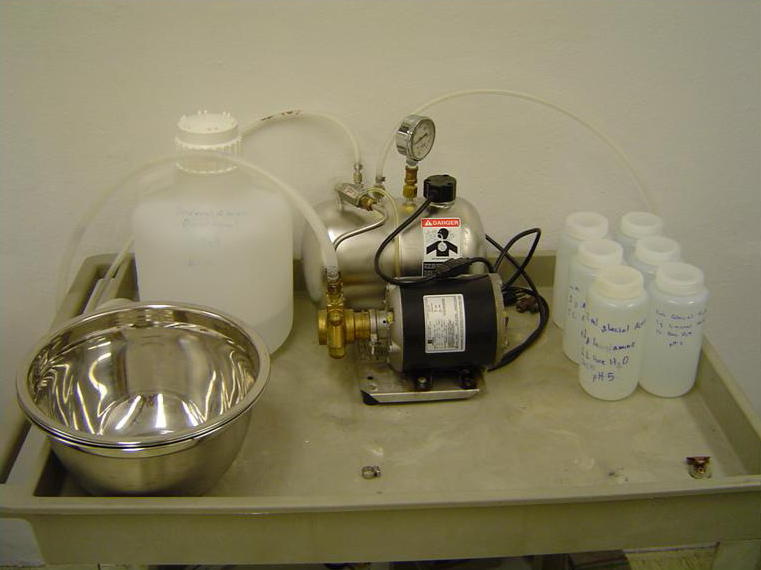
|
Froth Flotation
After being rinsed, if the sample contains feldspar and mica it will be frothed. To efficiently separate feldspar and mica from quartz, we have developed a procedure that makes feldspar and mica hydrophobic and the quartz becomes hydrophilic. By adding a carbonated solution to the sample, we can separate up to 95% of the feldspar. This greatly reduces the amount of acid and time that would be consumed to dissolve this feldspar and mica. In froth flotation it is very important to have a fresh, newly cracked surface. It is also just as important for the sample to be of the correct grain size (between 0.25mm-0.5mm), otherwise the grains will either sink or float. Materials: Soda carbonator Lauryl amine Recovery funnel Recovery flask Coffee filters Pure eucalyptus or pine oils Large 6-8 liter salad bowl Process: The frothing technique is done with a soda carbonator and a mixture of 1 ml/L glacial acetic acid and 1 g/L lauryl amine in 1 liter pure water. The lauryl amine dissolves better in the glacial acetic acid and keeps the pH ~5. This solution is then mixed with 10 liters water and then carbonated. The quartz must be pre-treated for 1 hour with a 1% solution of hydrofluoric acid. This hydroflouric acid solution changes the surface chemistry of the feldspar/mica and quartz grains making the feldspar/mica hydrophobic and the quartz hydrophilic. After 1 hour, decant the 1% hydrofluoric acid solution, *do not rinse and dry*, and pour the sample material into the large salad bowl. Add a few drops of pure pine or eucalyptus oil to the mineral mixture and then the carbonated solution. The pine or eucalyptus oil will hold the bubbles together and it will form a head (like on top of a beer) where the feldspar/mica will be. Wait a few seconds to let the solution of carbonated minerals settle down. Then, pour off the feldspar/mica and what is left will be quartz and other heavy minerals. Repeat if necessary. Biotite can not be separated this way, you need to use a magnetic separator. If you do not want the minerals simply let them go down the drain. If you want them for Cl36, pour into recovery funnel with coffee filter.
|
525 Northwestern Avenue West Lafayette, IN 47907-2036 Telephone: (765) 494-5381 Fax: (765) 496-7228
